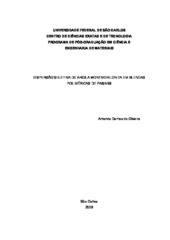| dc.contributor.author | Oliveira, Amanda Dantas de | |
| dc.date.accessioned | 2016-06-02T19:12:12Z | |
| dc.date.available | 2011-10-13 | |
| dc.date.available | 2016-06-02T19:12:12Z | |
| dc.date.issued | 2009-08-25 | |
| dc.identifier.citation | OLIVEIRA, Amanda Dantas de. Selective dispersion of montmorillonite organoclay in PA6/ABS blends. 2009. 197 f. Dissertação (Mestrado em Ciências Exatas e da Terra) - Universidade Federal de São Carlos, São Carlos, 2009. | por |
| dc.identifier.uri | https://repositorio.ufscar.br/handle/ufscar/843 | |
| dc.description.abstract | For some applications toughening of polyamide is important. This can be accomplished through the addition of an elastomeric phase to the polyamide matrix with the drawback of a reduction in the stiffness and strength of the material. Several studies lately have focused on the modification of polyamide matrix with the purpose of obtaining a balance between toughness and stiffness for these thermoplastics. In this work, to achieve a balance between stiffness and toughness, ternary nanocomposites based on blends of polyamide 6 (PA6) and acrylonitrile-butadiene-styrene (ABS) were prepared by the melt blending processes using the organoclay Cloisite® 30B (OMMT) and the styrene-maleic anhydride copolymer (SMA) as compatibilizer. Four blending sequences were used to prepare the selected systems and their mechanical properties studied through the Young s modulus and notched Izod impact properties. The addition of organoclay increases the Young s modulus of all ternary nanocomposites when compared to the blend and the PA6 matrix. This fact was attributed to preferential location of the clay in the PA6 matrix phase. The micrographs obtained by transmission electronic microscopy (TEM) indicate that the nanoclay shows an exfoliated structure and reside in the PA6 matrix phase, as well as in the interface between the phases. PA6/ABS/OMMT ternary nanocomposites with different content of nanoclay (1, 3 and 5%) were studied and it was observed that the particles size of ABS dispersed phase decrease with the increase of the OMMT content in the blend. This fact indicates that nanoclay can play an important role to prevent the coalescence in the ABS domains during the melt state processes. PA6/ABS ternary blends compatibilized with SMA were prepared by melt state process and it was observed that the mechanical properties and the morphology were influenced by the blending sequence of the components. | eng |
| dc.description.sponsorship | Universidade Federal de Sao Carlos | |
| dc.format | application/pdf | por |
| dc.language | por | por |
| dc.publisher | Universidade Federal de São Carlos | por |
| dc.rights | Acesso Aberto | por |
| dc.subject | Polímeros | por |
| dc.subject | Nanocompósitos | por |
| dc.subject | Blendas poliméricas | por |
| dc.subject | Tenacificação | por |
| dc.subject | Rigidez à flexão | por |
| dc.title | Dispersão seletiva de argila montmorilonita em blendas poliméricas de PA6/ABS | por |
| dc.title.alternative | Selective dispersion of montmorillonite organoclay in PA6/ABS blends | eng |
| dc.type | Dissertação | por |
| dc.contributor.advisor1 | Pessan, Luiz Antonio | |
| dc.contributor.advisor1Lattes | http://lattes.cnpq.br/8276650236213537 | por |
| dc.description.resumo | A tenacificação da poliamida 6 é desejável para diversas aplicações e pode ser obtida através da adição de uma fase elastomérica à matriz, entretanto, isto leva a uma perda em suas características de rigidez e resistência a tração. Com o intuito de se obter um balanço entre as propriedades de rigidez e tenacidade, nanocompósitos baseados em blendas de poliamida 6 (PA6) e terpolímero acrilonitrila-butadieno-estireno (ABS) foram preparados pelo método de mistura no estado fundido utilizando a argila organofílica Cloisite® 30B (OMMT) como reforço e o copolímero estirenoanidrido maleico (SMA) como compatibilizante. Os sistemas foram preparados em uma extrusora de rosca dupla co-rotacional, utilizando quatro sequências de misturas e suas propriedades mecânicas foram analisadas através da determinação do módulo de elasticidade sob tração e resistência ao impacto Izod. A adição da argila organofílica aumentou o módulo de todos os nanocompósitos ternários em relação à blenda e à matriz PA6. Mas por outro lado, foi observada uma redução da resistência ao impacto desses nanocompósitos. Este aumento na rigidez foi atribuído à localização da argila no interior da fase matriz PA6. As micrografias obtidas por microscopia eletrônica de transmissão (MET) indicaram que a argila apresenta uma estrutura esfoliada em todos os sistemas e reside na fase matriz PA6, bem como na interface entre as duas fases. Sistemas ternários de PA6/ABS/OMMT com diferentes teores de argila (1, 3 e 5%) também foram estudados e foi observado que o tamanho das partículas da fase dispersa ABS diminui com o aumento da quantidade de OMMT na blenda. Isto indica que a argila pode desempenhar um importante efeito em prevenir a coalescência dos domínios de ABS durante a mistura do fundido, estabilizando a estrutura formada. Blendas ternárias de PA6/ABS compatibilizadas com o SMA foram preparadas e foi observado que as propriedades mecânicas e a morfologia são bastante influenciadas pela ordem de mistura dos componentes da blenda. | por |
| dc.publisher.country | BR | por |
| dc.publisher.initials | UFSCar | por |
| dc.publisher.program | Programa de Pós-Graduação em Ciência e Engenharia de Materiais - PPGCEM | por |
| dc.subject.cnpq | ENGENHARIAS::ENGENHARIA DE MATERIAIS E METALURGICA | por |
| dc.contributor.authorlattes | http://lattes.cnpq.br/0010723066123700 | por |
